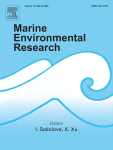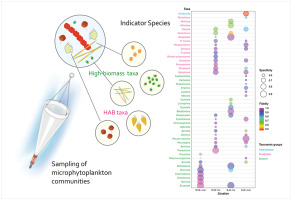Harmful algal blooms (HABs) were not new to the tropical semi-enclosed Johor Strait, with incident records that could trace back to the 1980s. HAB monitoring in the area, often, is reactive, focusing only on HAB taxa previously causing problems but neglecting potential emerging HABs. To develop datasets on HABs that can better inform and improve management practices, monitoring should expand to sample whole microphytoplankton communities. In this study, microphytoplankton community structure across the Strait was investigated. Abundances of microphytoplankton and a suite of in situ water parameters of temperatures, salinity, pH, dissolved oxygen levels, macronutrients, and chlorophyll-a contents were collected at ten sites across the Strait at monthly intervals from January 2017 to December 2018. A total of 48 genera (51 taxa) microphytoplankton were identified microscopically. Diatom was the most diverse group (32 genera), followed by dinophyte (15 genera). Bloom-forming species included diatoms Chaetoceros, Coscinodiscus, Eucampia, Pseudo-nitzschia, Rhizosolenia, Skeletonema, Thalassiosira, and dinophytes Blixaea quinquecornis and Scrippsiella. Diatom taxa that exhibit high in situ growth rates were predominant in the low-nutrient marine-influenced environment. Bloom-forming taxa including HAB taxa were found dominant in the environment with high nutrient levels and mesohaline, salinity-stratified conditions. This study provides valuable baseline data that could assist in monitoring and prediction of HABs in the Johor Strait and could be of reference to other similar tropical coastal systems.



